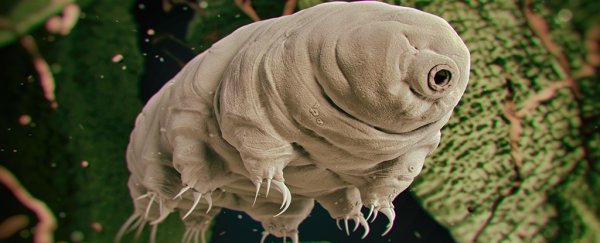Asteroid impact, exploding stars, intense bursts of radiation… a whole variety of astronomical events could see the end of the human species, not to mention the destruction of all manner of global ecosystems.
But according to new research, a microscopic animal known as a water bear – or, when applying for jobs, a tardigrade (Milnesium tardigradum) – simply DNGAF about global catastrophes. This little critter is robust enough to walk out of some of the worst case doomsday scenarios with a smug smile on its tiny face.
None of this should come as much of a surprise to tardigrade fans, who know this super-powered beast can survive nearly anything nature throws their way.
Freeze it, boil it, starve it, dehydrate it, radiate it, or even stick it out into the vacuum of space, and this 0.5 millimetre long, eight-legged, Wolverine-wannabe only comes back for more.
Tardigrades are animals that have an entire phylum to themselves, because of course they do. Not to mention most of the planet to roam – they can be found just about anywhere. Go outside now and there'll be a bunch smirking at your pathetic weakness on your lawn.
Several years ago an analysis of its genome revealed 17.5 percent of its genes were stolen from other species, making them virtual Uncanny X-bears.
Let's face it, we might worry about an end of days, but the tardigrade isn't bothered.
"A lot of previous work has focused on 'doomsday' scenarios on Earth – astrophysical events like supernovae that could wipe out the human race. Our study instead considered the hardiest species – the tardigrade," says Oxford University researcher David Sloan.
There's little doubt that our planet really belongs to the bacteria and archaea, with extremophiles buried deep under the crust, calling some pretty inhospitable conditions home. Even if Earth was ripped into shreds, it's likely that there'll be plenty of single celled organisms clinging onto the new asteroid belt, slowly metabolising.
To test the water bear's limits, the researchers settled on possible events that blast the surface with enough heat to remove protective coverings of water and atmosphere. They considered three types of astronomical events that could possibly see an end to a number of species on Earth; large asteroid impact, supernovae, and gamma-ray bursts.
To raise our planet's ocean temperature enough to have them boil away, the researchers came up with a conservative estimate of a mass larger than 1.7 × 10^18 kilograms colliding with Earth.
There are 17 asteroids of that size, not to mention dwarf planets such as Pluto and Eris.
The shock wave produced by a supernova within 0.1 light years (0.04 parsecs) could also be enough to make the oceans evaporate away.
Lastly, a concentrated jet of gamma rays bursting from a star within 13.8 parsecs (45 light years) would also see ocean temperatures reach boiling point, providing a third boundary to base any predictions on.
None of these scenarios are likely to occur any time soon. A supernova that close might occur once every hundred billion years.
These scenarios set a limit on what we could expect to trigger something as extreme as a planetary roasting, but it's possible smaller events could set off chain reactions that might slowly lead to other disastrous events. Venus didn't turn into Hell overnight, for example.
In any case this is good news for water bears, who no doubt already knew that. Sure, they might be all alone, possibly reduced to mummified bodies on a barren rock for want of water, but even a hollow victory counts.
It's also good news for alien hunters.
"Tardigrades are as close to indestructible as it gets on Earth, but it is possible that there are other resilient species examples elsewhere in the Universe," says researcher Rafael Alves Batista from Oxford University.
"In this context there is a real case for looking for life on Mars and in other areas of the Solar System in general. If tardigrades are Earth's most resilient species, who knows what else is out there?"
With questions on whether life could survive around red dwarf stars, having some actual numbers describing the hardiness of different life forms on Earth could be useful.
It's also comforting to know just how robust living chemistry is in the face of a hostile Universe.
"Huge numbers of species, or even entire genera may become extinct, but life as a whole will go on," says Sloan.
This research was published in Scientific Reports.
